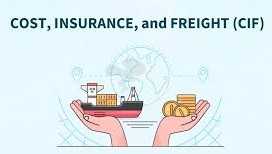Introduction: What Is CIF Shipping?
International trade can feel overwhelming at first—especially when you’re just starting out. You come across dozens of logistics terms, and suddenly, buying or selling across borders becomes a legal maze. One term you'll likely hear often is CIF shipping. But what exactly does it mean?
In this guide, we’ll break down everything you need to know about CIF shipping—from its definition and responsibilities to the pros and cons. If you’re a business owner, a first-time importer, or someone looking to expand globally, this beginner-friendly breakdown will help you make better shipping decisions.
Let’s dive in.

What Does CIF Stand For?
CIF stands for Cost, Insurance, and Freight. It is one of the most common Incoterms (short for International Commercial Terms), and it's primarily used in sea and inland waterway transport. Under a CIF agreement, the seller is responsible for arranging and paying for the transportation of goods to a specified port, as well as providing insurance for the shipment.
However, here’s where it gets interesting: Ownership of the goods transfers to the buyer once the goods are loaded on the ship, not when they arrive at the destination port. This makes CIF different from other terms like FOB (Free On Board), where risk and cost transfer happen differently.
To understand the difference between CIF and other shipping methods, we need to look at what each party is responsible for.
Who Takes Responsibility in CIF Shipping?
One of the main things to know about CIF shipping is how the responsibilities are divided.
The Seller’s Responsibilities
The seller must:
Pay for transporting the goods to the port of destination.
Handle export customs clearance.
Cover marine insurance to protect the goods during the journey.
Deliver goods on board the shipping vessel.
The Buyer’s Responsibilities
The buyer is responsible for:
Import duties, taxes, and customs clearance at the destination port.
Arranging transportation from the port to the final destination.
Handling any additional insurance beyond the seller’s coverage.
As you can see, CIF shipping terms simplify international trade for buyers because the seller manages the majority of the process—at least until the goods are on the ship.
Why Choose CIF Shipping?
So why do so many people use CIF shipping in their contracts? The answer lies in its convenience and upfront cost transparency.
Benefits for Buyers
Less Hassle: The seller handles the heavy logistics and insurance.
Cost Predictability: Since shipping and insurance are included in the price, budgeting becomes easier.
Reduced Risk (to a point): Goods are insured, providing peace of mind while they’re in transit.
Benefits for Sellers
Control Over Shipping: Sellers can work with their preferred logistics partners.
Better Margins: Some sellers can negotiate better freight deals and include a markup.
Customer Satisfaction: CIF offers a smoother experience, especially for first-time importers.
Drawbacks You Should Consider
While CIF shipping offers convenience, it's not perfect. Understanding the limitations can help you avoid surprises.
For Buyers
Limited Control Over Shipping: Since the seller picks the carrier and insurer, buyers may not get the best rates or terms.
Higher Risk After Loading: Although the seller pays for insurance, the buyer assumes ownership once the goods are loaded. If anything goes wrong beyond that point, the buyer must deal with the insurer.
Hidden Costs: CIF pricing might look attractive, but sellers may inflate freight and insurance costs.
For Sellers
More Responsibility: Sellers must handle logistics, insurance, and potential issues at the loading port.
Legal Complications: If disputes arise, determining liability can become complex, especially when dealing with international laws.
CIF vs FOB: What's the Difference?
A lot of confusion arises when comparing CIF shipping to FOB (Free On Board). While both are used in sea freight, the main distinction lies in when the risk transfers from the seller to the buyer.
| Term | Cost Covered By Seller | Risk Transfers When | Insurance Required? |
|---|---|---|---|
| CIF | Up to destination port | When goods are loaded | Yes |
| FOB | Up to ship loading | When goods are loaded | No |
In simple terms, CIF includes insurance and freight, while FOB does not. This makes CIF a better option for buyers who want a hassle-free shipping solution.
How CIF Shipping Works: Step-by-Step Example
Let’s say a clothing manufacturer in India is exporting 10,000 t-shirts to a retailer in the United States under CIF shipping terms.
Contract Signed: The agreement specifies CIF New York.
Seller Prepares Goods: T-shirts are packed and made ready for export.
Export Customs Cleared: The seller handles all customs documentation.
Goods Shipped: The seller books freight, pays for marine insurance, and gets the goods on board.
Risk Transfers: Once loaded onto the ship, the buyer now owns the goods.
Goods Arrive: The buyer arranges customs clearance and pays any import duties.
Final Delivery: The buyer transports the goods from the port to their warehouse.
Even though the seller paid for insurance, if the goods are damaged during transit, the buyer must file the claim.
When to Use CIF Shipping
CIF shipping is ideal for:
First-time international buyers unfamiliar with logistics.
Small businesses looking for cost predictability.
Buyers who prefer the seller to manage most of the shipping process.
However, larger buyers or experienced importers may prefer alternatives like FOB or DDP (Delivered Duty Paid) for better cost control.
Legal and Insurance Considerations
When it comes to CIF shipping, insurance is often misunderstood. While the seller is required to provide marine insurance, it usually only covers the minimum—typically 110% of the invoice value under Institute Cargo Clauses (C). This may not be enough if your goods are valuable or sensitive.
If you're a buyer, consider purchasing additional coverage to ensure you're fully protected. Also, ensure your contract clearly outlines terms like who handles claims and the jurisdiction for legal disputes.
CIF Shipping in the Modern World
With the rise of global e-commerce and third-party logistics (3PL) providers, CIF shipping remains relevant. In fact, platforms like Alibaba often use CIF quotes to simplify transactions for small buyers around the world.
However, as global regulations evolve, understanding Incoterms like CIF is more important than ever. Knowing your responsibilities, rights, and risk exposure could save you time, money, and headaches down the road.
Conclusion
CIF shipping is one of the most widely used Incoterms in international trade—and for good reason. It offers convenience, cost predictability, and a lower barrier to entry for international buyers. But like any trade agreement, it has pros and cons.
If you're considering CIF for your next deal, make sure you understand where your responsibility begins and ends. That way, you can avoid costly mistakes and keep your global supply chain running smoothly.








